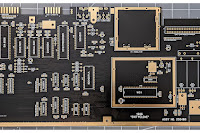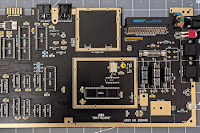
As you get more confident with your photography, you will start to encounter occasions where some accessories could be used to aid you and this article is intended to address the most common accessories. I think it's all too easy to start to get caught up in what is called GAS (Gear Acquisition Syndrome) and whilst you’re very welcome to spend as much money as you please on whatever you want I only ask that you bear in mind that there is only so much that you can reasonably carry and that there is an awful lot you don’t need. I’m firmly in the camp of keeping things simple and keeping costs under control but other opinions, as always, are available. All the gear in the world is no substitute for a great composition but there's no doubt it can help make a good photo great.
For the most part the gear I talk about below can be used with pretty much any digital camera.
Filters
Tripods
If you’ve read through the description of the filters you’ll be aware that in some cases a tripod is necessary. And this is especially true for long exposures where the camera must be kept completely still. I can hand-hold my camera and get consistently sharp pictures at around 1/60th of a second. For anything longer I'd need to consider a tripod.
Most modern cameras have something called “image stabilisation” built in. What this does is very cleverly stabilise the light hitting the camera’s sensor and this allows you to take a sharp picture hand held at relatively slow shutter speeds, however, even this very clever technology has its limits and for long exposure’s a tripod is generally considered an essential.
As with all camera accessories, the choice here is virtually endless and I would never recommend a specific brand or model. However, I would say if it doesn’t hold your camera firmly and without shake then it’s a waste of money so buy something which is rated for the weight of your camera, and if it’s a DSLR, the weight of the heaviest lens you’ll use it with.
L-Brackets
 |
| An L-Bracket |
An L-Bracket is simply a plate which screws to the tripod mount in the bottom of your camera, and which replaces the standard plate which comes with a tripod. The benefits of this are quite obvious: with one of these you will no longer have to tilt your tripod head 90 degrees to take a portrait oriented photo. Instead you can simply place your camera into the tripod clamp in landscape or portrait orientation as you see fit. I discuss L-Brackets in more depth in this article.
Shutter Release Cable
 |
| Shutter release cable |
Using a shutter release cable means that you can take a picture without touching your camera and this reduces camera shake. Camera shake means unintentionally blurry photos and blurry photos are wasted photos. DSLR cameras have something called “Bulb Mode” which is a shutter speed setting. Most digital camera’s will allow you to select a shutter speed of 15 to 30 seconds. If you want to have the shutter open for longer than this then, on DSLRs, you have the option of selecting bulb mode and by using your shutter release cable, keep the shutter button pressed down for an exposure of virtually any duration you like. In its simplest form a Shutter Release Cable is simply a cable which plugs into a specific port on your camera at the end of which is a handheld box with a shutter button on it – other, far more complicated types (called Intervalometers) are available and with these you can program the shutter speed and number of pictures to be taken over a specified period of time. Once again I would never deign to recommend one type, brand or model over another as your needs will be different from mine but the internet is full of articles to help you research and decide.
Camera Strap
The chances are any large camera you buy will come with a neck strap in the box. My experience with these straps is a long way short of satisfactory and I've never had one that was any good. If carrying my camera is uncomfortable I'm not going to enjoy using it and if I'm not enjoying it I'll leave the camera at home so for me it was vitally important to buy a strong, long, versatile strap which I could wear conventionally (around the neck) when taking pictures, and then sling across my body for optimum comfort while walking about. Remember, a camera and lens is a lot of weight pulling on your neck all day so it's worth exploring all the many options available to make you as comfortable as possible.
Spare Battery
Have at least one spare battery. Remember, no battery = no pictures. If you know roughly how many pictures your camera will take before the battery dies, and you ever anticipate taking more than this, get a second battery. Remember too that the temperature can affect battery life: very cold temperatures can drain batteries very quickly so having at least one spare that you are keeping warm beside your body should keep you going.
USB Battery Charger
This was one of the best pieces of advice I ever received. Some digital cameras can be charged directly through a built in USB port which is great. However, some can't and for those it is definitely worthwhile buying a USB charger for your camera's battery. Because charging via USB is near ubiquitous the world over you will be able to charge your battery in the car or from a power bank when you're on the go, and via the mains supply in almost any country without having to carry the charging adaptor, plug and cable that came with the camera plus an adaptor plug (if you're abroad). The only thing better than having one of these is having two.
Power Bank
 |
| Power Bank |
A power bank is simply a rechargeable battery with USB inputs (to charge the power bank itself) and USB outputs to recharge your electronics, including your camera battery (if paired with a USB battery charger). This is invaluable when you're out and about and not near another charging source.
Power Banks come in various dimensions from small pocketable sizes to much larger for keeping in a bag. They are rated in mAh (milliampere hours). The larger the mAh, the more times you will be able to charge your device before the power bank itself needs charged.
Dust Blower
 |
| Dust blower |
You will want to keep your lenses and camera free of dust. What you don't want to be doing is blowing spit all over them and this where a dust blower comes in. Use one of these to blow away dust and grit before cleaning any smudges with a lens cloth. I keep a cheap dust blower with me all the time.
Lens Cloth
A lint free lens cloth will clean up fingerprint marks from your lens and LCD screen. Keeping these clean ensures your pictures are free from blurry marks and that you can see your picture clearly. Simple. Again, I always have a couple of these with me.
Lens Pen
 |
| Lens Pen |
What I like about a lens pen is that they come with a brush which is very helpful for removing small detritus from around my lenses and in the nooks and crannies of the camera body. I don't tend to use this on the lens glass as I prefer to use the dust blower here - to avoid scratches you don't want to be rubbing or brushing any grit onto the glass of your lens. These too are very inexpensive and handy things to have with you all the time.
Pre-Moistened Lens Wipes
I bought a large box of these. Each comes in it's own foil sealed pouch to keep it fresh and I carry dozens with me. They're particularly good for removing stubborn smudges and fingerprints.
OTG Cable
 |
| OTG Cable, USB SD card reader and USB Flash Drive |
OTG (On The Go) Cables are simply USB cables that attached to your mobile phone and allow you to attach USB accessories such as flash drives, portable hard drives and SD Card readers. With one of these you can copy pictures from your camera's SD Card to your phone and from there you can edit on the go, keep as a backup and/or copy to a USB flash drive.
USB Flash Drive
Many people carry rugged hard drives with them when they're away from home. I've rejected this in favour of cheaper and lighter flash drives. I usually have a couple (one spare) and in conjunction with an OTG cable use my mobile phone to back up my pictures on to it. At 64GB one of these is more than enough to hold all my pictures (RAW and JPEG) from a fortnight's vacation and provides a great, cheap backup solution. Two gives that extra piece of mind. There's an article coming in the future that covers my backup solutions in more depth. This works for me as I very rarely travel with my laptop so I don't tend to edit on the go and so don't need fast read/write speeds.
Monitor Calibration
This is much more complicated and is probably worth an article all by itself however, in brief, I like to keep the colour of my pictures consistent. To do this I need to ensure that what I see as white on my monitor really is white with no subtle colour casts. For example, if my monitor has a very slightly yellow hue (warm) then when looking at a picture of nice white clouds they will seem slightly yellow too. If I try to correct this, by making them bluer (cooler) they may look correct on my slightly yellow monitor but if I were to print them they would now be too blue. I used to drive myself absolutely nuts with this stuff until I finally decided enough was enough and invested in proper monitor calibration hardware that actually measured the colour on my monitor and produced an accurate colour profile which made all the difference in the world. Every monitor you can buy will have very subtle and very different colour casts and I found only proper calibration made this problem go away.




